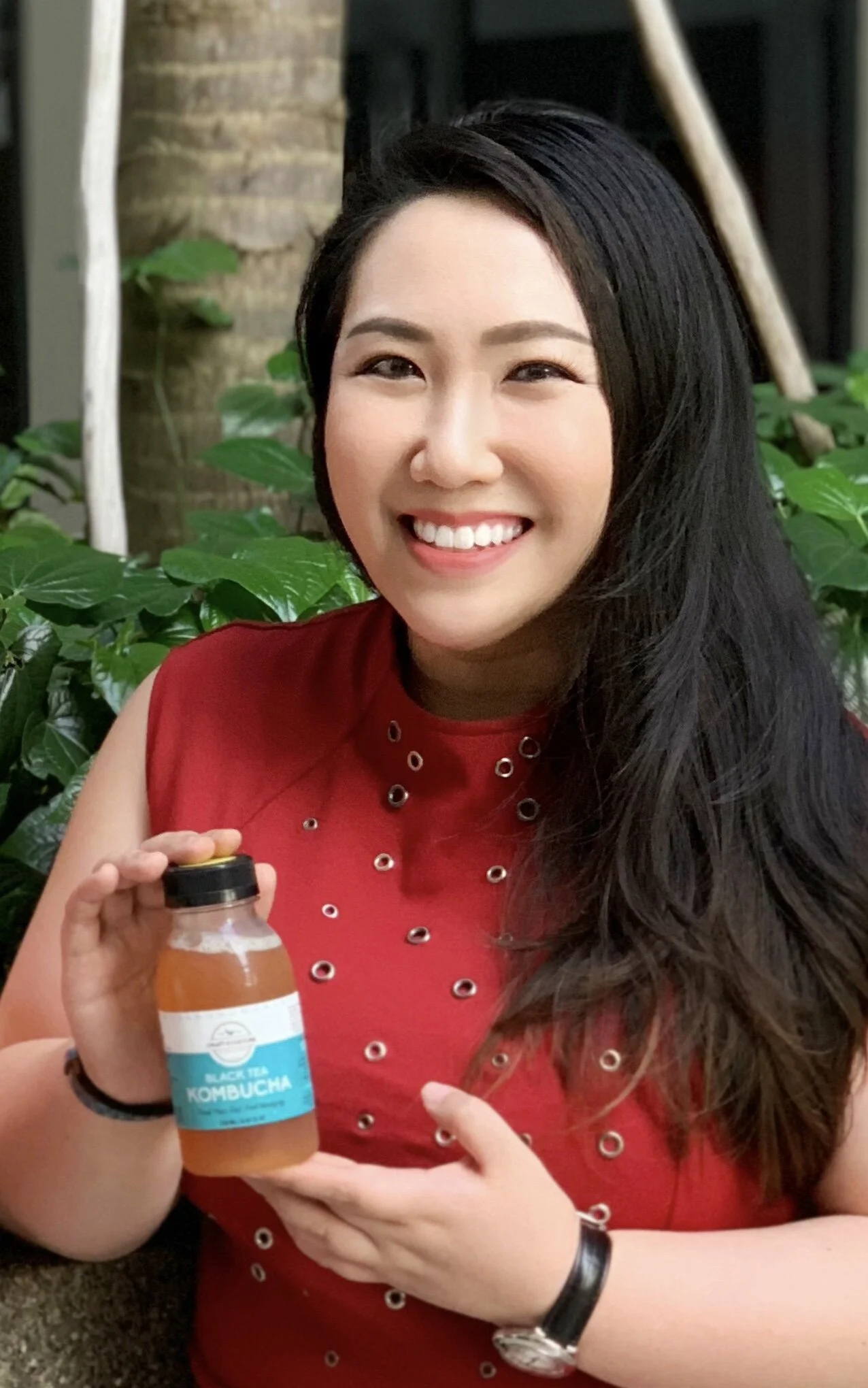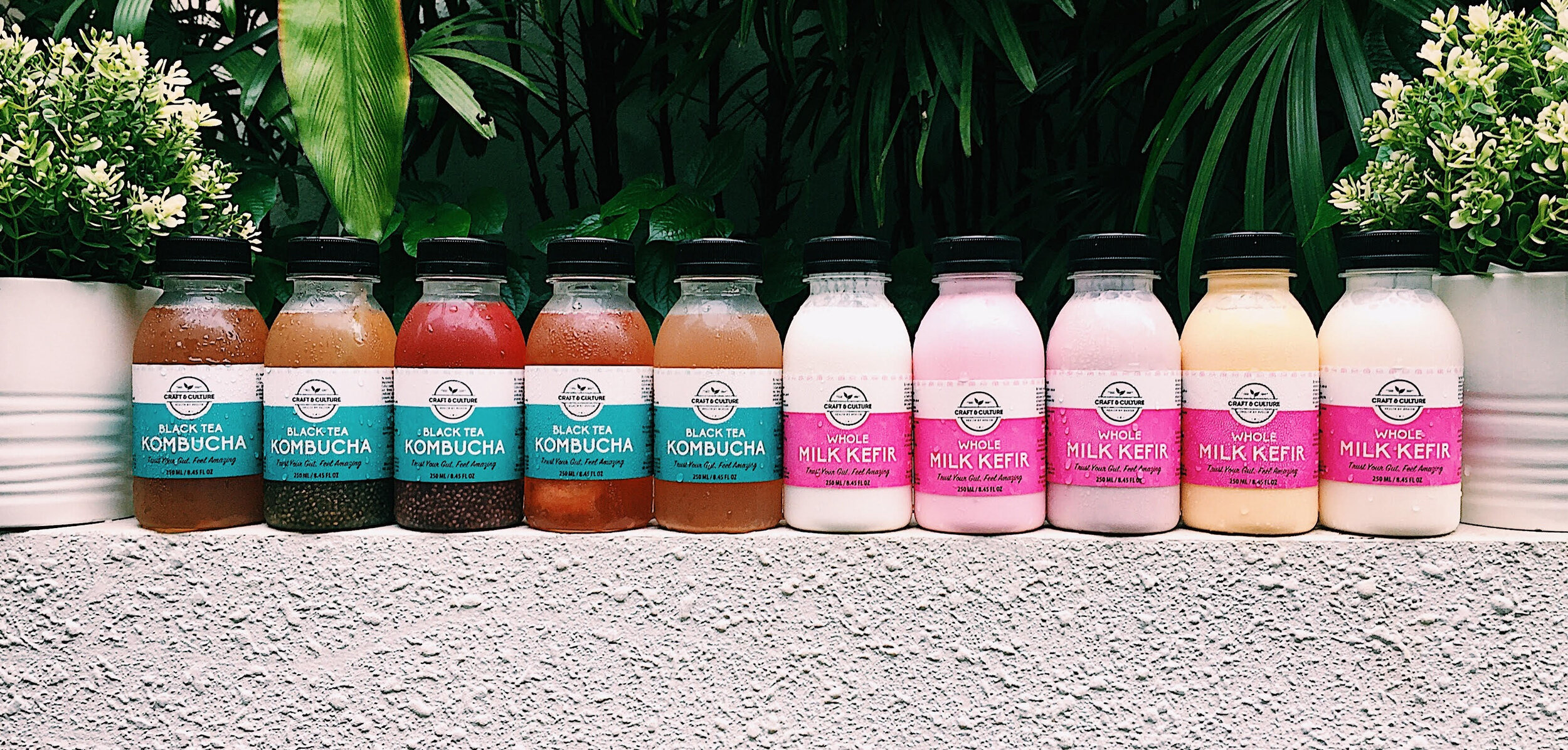The Skin-Gut-Health Connection is real.
At Chez Moi, we’ve seen how our clients’ skin issues start to improve when they switch to a healthier diet, cut their sugar intake, and incorporate more enzymes and probiotics into their diet.
An easy way to improve gut health is to add fermented, gut-friendly foods into our diet.
In this post, we reach out to fermentation-insider Winnie Ong from local Kombucha brewery Craft & Culture to find out more about her journey to better gut health, and the benefits of fermentation for gut-microbiome.

Winnie Ong from Craft & Culture
What inspired you to start Craft & Culture?
Winnie: Craft & Culture was started when my business partner and I connected over the love of fermentation on a business trip; both of us have about 25 years of experience combined as we’ve done exotic ferments like garums, mead, tepache and more over the years!
As incorporating fermented foods into one's regular diet is fairly uncommon in Singapore, Craft & Culture was started in order to raise the awareness of how prebiotics and probiotics are vital to maintaining good health. Seeing the potential as no one in Singapore was providing Kombucha and Kefir at the time, we took some time to plan and regroup and started Craft & Culture in 2015. We are a proudly Singaporean-owned brewery and have expanded our product and services range to include workshops, kits and even natural skincare made with Kombucha.
Initially, only family and friends were buying from us. It was a pleasant surprise when they started introducing our brews to their friends, who in turn, purchased from us. The business started seeing increased sales as the media started introducing kombucha and kefir to the masses.
When did you first discover the benefits of fermentation?
Winnie:
70% of our immunity system lies in our gut so making sure that our intestines are populated with good bacteria means falling sick less often.
I have lifelong issues with allergies and eczema. When my immune system was at its weakest, I was taking steroids for several months. As my gut health was in bad shape, I was frequently ill, had insomnia issues, bloating and indigestion and itchy, inflamed skin.
Coming from a medical science background, I was acutely aware that steroids cause withdrawal and even liver damage in the long term.
I was living in the United States then and some friends recommended I try kombucha as a natural means of managing my allergies and digestive problems.
I was pretty skeptical but started taking kombucha daily for two weeks... and felt gradual but positive differences during that period.
I experienced better sleep and resolved the bloating, indigestion and constipation issues that were plaguing me. At the end of two weeks, I found that my skin was less red and inflamed and was clearer.
Intrigued, I started reading medical journals and clinical studies on probiotics and fermented foods. Knowing the science behind it was a eureka moment as the facts clicked together with my personal observations while taking kombucha daily. My journey with brewing kombucha started in 2006 so it’s been a long time since then!
Let’s talk about the skin-gut-health connection. How can eating fermented products help to improve our gut and skin health?
“All Disease Begins in the Gut” - Hippocrates
Winnie: The main buzz on fermented foods lies in how good they make people feel. People who take fermented foods regularly feedback that they feel a general sense of wellness, characterised by higher energy levels, elimination of bloat, improved immunity against common illnesses and clearer skin.
Fermented foods are incredibly rich in vitamins, antioxidants and nutrients and promote cell functions. They also contain a variety of beneficial bacteria and yeasts.
As 70% of our immune system lies in our guts, having a healthy and balanced gut biome with good bacteria and yeasts are key.
Medical research suggests that healthy guts with good flora strongly correlate with excellent heart health, boosted immunity, reducing stress and depression, relieving allergic symptoms and great skin to name a few.
Are there any side effects to taking Kombucha or Kefir that we should be aware of?
Winnie: Side effects are very rare but they can happen especially for people who have weak immune systems or people who were on antibiotics. For example, there may be short-lived undesirable symptoms that appear depending on the general health of the consumer.
If one’s gut health isn’t optimal, sometimes upon consuming probiotics food like milk kefir, kombucha or other fermented food, they might experience the “Candida Die-Off” or detox reactions. This happens when probiotics are introduced into the body and yeast cells are rapidly killed, a die-off (or Herxheimer reaction) occurs and metabolic by-products are released into the body.
Candida yeast cells release about 79 different toxins when they die, including ethanol and acetaldehyde. These toxins cause allergic reactions and inflammation that lead to an array of undesirable symptoms like diarrhoea, headaches and hives. Die-Off symptoms could vary as everyone’s microbiomes are unique.
If one experiences severe Die-Off symptoms, simply reduce the serving size and hydrate often, and continue daily until the symptoms ease up on their own.
Continuing the course of probiotics while having detox reactions is crucial as some people mistake detox reactions for food poisoning and give up at the very onset.
The liver is the main pathway for eliminating toxins, and the Die-Off symptoms mean that it is being overwhelmed. We typically advise for probiotics to be reintroduced slowly as the die-off symptoms lessen.
What does your usual diet look like, and how does it incorporate fermented food/drink?
Winnie: Fermented foods are a nutritious and delicious way to supplement my diet. I start my day with a bottle of kefir with fruit in the morning on an empty stomach and take 1 big glass of water. As kefir contains lots of good fats, I am pleasantly full until lunch time.
My lunch usually consists of protein bowls with good fats and complex carbohydrates for mental clarity and productivity.
In the mid to late afternoon, I snack on nuts and fruits and take a bottle of kombucha to prep my gut for better nutrient absorption for dinner!
For dinner, I introduce a range of ferments on a regular basis. For example, warm and hearty miso soups, tempeh stir fries with sambal, kimchi, lacto-fermented pickles etc.
How do we evaluate the qualities of a drink like kombucha? What makes one brew better than the other?

Delicious fermented drinks from Craft & Culture
Winnie: A good kombucha has a balance of tartness and mild sweetness and can be enjoyed flat when it’s at its freshest or slightly sparkling.
Kombuchas should not be:
- Too sour: This indicates that the fermentation rates are too rapid and that sugars are converted into mostly vinegar instead of a range of beneficial compounds that are obtained from slow, controlled fermentation
- Extremely low sugar or sugar free: Sugars are a food source for probiotics bacteria so using almost no sugar or only sugar substitutes like stevia/monkfruit/erythritol results in brews with low probiotic counts and yeasty profiles.
- Bland and overly dilute: Kombuchas are incredibly flavourful and acquire a fruity profile with slow fermentation on their own. Certain commercial brands tend to over dilute their brews for commercial viability and introduce force carbonation for fizziness, resulting in kombuchas that taste like flavoured seltzer water.
- Kept too long: As a raw product, there is a tendency for probiotic bacteria to run out of sugar as a food source, resulting in yeasty brews when stored several months.
- Made using anti-bacterial ingredients which may kill probiotic bacteria: Earl grey tea (containing bergamot oil), lemongrass, honey (unless it’s jun kombucha)
What’s your favourite brew in Craft and Culture’s repertoire?
Winnie: That’s a tough one. I would say the lychee kombucha and the strawberry milk kefir.
What advice would you give to beginners looking to incorporate the benefits of fermentation into their diet?
Winnie: The key step to really benefit from fermentation is to take a variety of fermented foods so our gut biome is well balanced with a bit of everything. Cultivate a library of beneficial bacteria!
Different bacteria do different things - kombucha bacteria is great for joint and mental health, while kefir bacteria help with reducing inflammation, managing eczema and helping with acid reflux and heartburn etc.
In terms of probiotic diversity, Kombucha contains up to 40 strains of bacteria and yeasts, while Kefir has up to 60. In comparison, yogurt drinks contain approximately 2-5.
Lastly - do you have a fermented food tip or recipe to share?
Winnie: Yes! We are not vegans but we absolutely love kombucha-fermented cashew recipes! We use it to make vegan cheeses and healthy desserts.
Check out our favourite kombucha-fermented passionfruit cheesecake below. This cheesecake will keep in the fridge for 4-5 days or can be frozen for up to three months (defrost in the fridge before serving).
Vegan Passionfruit Cheesecake
Crust:
- 2.5 cups of almond meal
- ¼ cup maple syrup
- 6 tablespoons grapeseed oil or coconut
Filling
- 300g raw cashews
- 250-300 ml of Craft & Culture kombucha (original)
- 3 tablespoons of coconut oil
- 75g coconut milk
- 150g Sugar
- Pinch of salt
- Pulp of 4 passionfruit
Method:
- Place 300g of cashews in a bowl and cover with Craft & Culture kombucha. Cover and leave at room temperature to soak overnight. Once soaked, strain the kombucha from the cashews but keep the liquid for the cheesecake batter and passionfruit topping.
- Preheat the oven to 160 deg C.
- Combine all of the crust ingredients. Press into a lined tart tin (22cm wide and 2.5cm deep) along the bottom and sides. Bake in the oven for 10 minutes or until the sides are slightly golden-brown.
- Blend the soaked and drained cashews with coconut oil, coconut milk and 100g sugar (adding a little more to taste, if needed). Add a pinch of salt, too, to taste. Blend until smooth, adding 1-2 tablespoons of the reserved kombucha for both flavour and to help bring the mix together into a smooth, creamy filling. The resultant mixture should be viscous like pancake batter
- Spoon the filling over the chilled base. Pop in the fridge for 4-6 hours or in the freezer for 1 hour to set.
- Heat the passionfruit pulp with 50g of sugar until the sugar dissolves and mixture thickens. Set aside to cool. Spoon over the cheesecake before serving.
Find Craft & Culture at:
Website: https://www.craftculturesg.com/
Facebook: https://facebook.com/craftculturesg/
Instagram: https://www.instagram.com/craftculturesg/
Email: support@craftculturesg.com
Facebook: https://facebook.com/craftculturesg/
Instagram: https://www.instagram.com/craftculturesg/
Email: support@craftculturesg.com
No comments:
Post a Comment
Note: Only a member of this blog may post a comment.